We are almost halfway through the sewing year! Time for me to just keep plugging along, being grateful for any hours I can spend sewing – or dreaming about sewing. Lately it seems I have spent more time dreaming about it than actually accomplishing anything. But that’s not quite true. I have actually done a lot of sewing (I call it necessary sewing) – just not anything worth sharing. But that is about to change.
I am working on a yellow linen shirtdress, using this pattern:
I am really getting to be a fan of kimono sleeves. They were incredibly popular in the 1950s (and early ‘60s), and their construction varies according to the type of gusset used. The dress in this pattern has a gusset that forms part of the sleeve, itself.
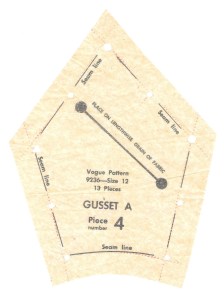
Usually gussets are diamond shaped. However, the curved lower edge shows that this gusset incorporates part of the sleeve in it.
The instructions for inserting the gusset are quite explicit and interesting, I think. The first step is to work a “bar” across the point on the bodice where the matching point of the gusset is placed. I have actually never seen this done, but it makes sense as it reinforces that stress point.
I also like the double stitching on the interior seams of the gusset as shown in this section:
Here is how the finished short sleeve is diagrammed:
And here are some photos of the finished gussets on my dress:

Here is an inside look. While the dress is underlined in a very light weight cotton/linen blend, I opted not to underline the gusset, in order to add to flexibility. I got this brilliant idea from Laura Mae of Lilacs and Lace sewing blog.

The seam you see at the top of this photo is the shoulder seam which runs down the length of the sleeve.
I managed to tear myself away from my sewing room for a few hours this week to go to see an exhibit at the Michener Museum in Doylestown, Pennsylvania (USA). Entitled Philadelphia In Style, the exhibit featured fashions either made, worn or purchased in Philadelphia, PA over the course of about 100 years (1880-1980).
All are part of the Robert and Penny Fox Historic Costume Collection at Drexel University in Philadelphia, a veritable treasure trove of designer, haute couture and ready-to-wear dresses, coats, ensembles, shoes, handbags, and accessories of all types. The Exhibit has special meaning for those of us with Philadelphia ties, but universal meaning for lovers of fine fashion anywhere.
Although the clothing on display was fascinating and, for the most part, lovely, it was the numerous fashion illustrations, framed and lined up one after the other, which really caught my attention. They had all been done in 1954 for a specialty ladies’ shop in Philadelphia, called Nan Duskin. The most amazing thing is that each one had a swatch of the intended fabric taped in the corner of each drawing. Here is a sampling:
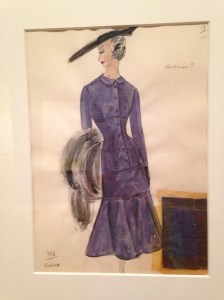
The buttons were still in question for this dress – note the line in the upper right side “buttons?”
Here are a couple of the fashions represented in the Exhibit:
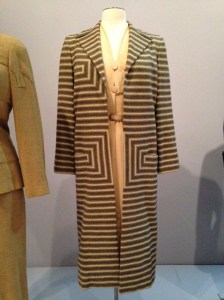
This was called a Day Ensemble. It bears the table “Irene for Nan Duskin.” (Irene Lentz Gibbons, 1952-53, USA)

This shirtwaist dress, Norman Norell for Trina-Norell, circa 1955, had finely done bound buttonholes. The fabric is silk and wool brocade.
The Exhibit did manage to include one of the most unattractive Chanel suits I think I have ever seen.
But it was still fascinating to look at the cuff detail:
One of the most charming displays in the Exhibit was a collection of hat boxes from the stores in Philadelphia which were the purveyors of so many fine fashions over the decades.
As a lover of pretty boxes and bags, I found this vignette not only delightful, but also evocative of the thought and care inherent in buying and wearing beautiful fashions. They reminded me of the same little thrill I get when a piece of beautiful fabric which I have purchased shows up in the mail, elegantly presented in crisp tissue and tied with silky ribbons. It makes it oh-so-easy to fall in love immediately!

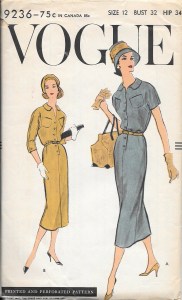
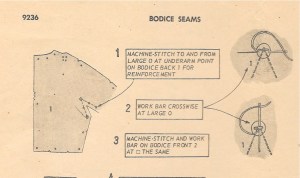
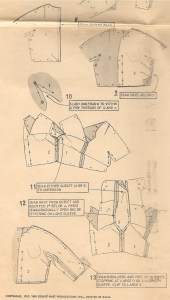
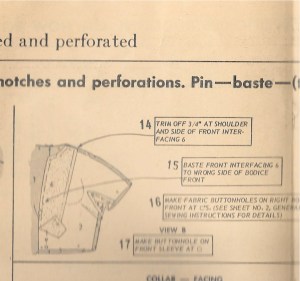

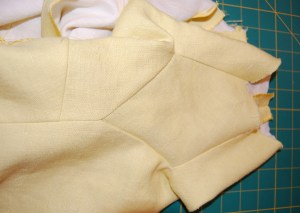

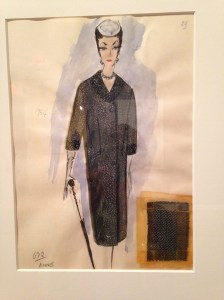
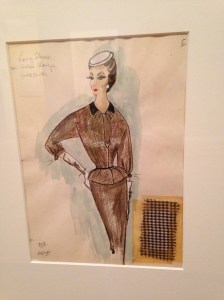
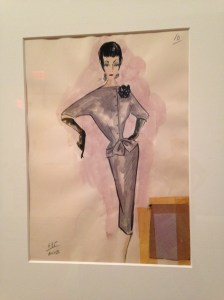
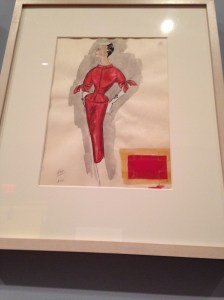



Love these photos, especially the Chanel and the Vogue and completed gusset scans. Good timing too; I’d just put up a post with scans of often contradictory gusset instructions from Evenlyn Mansfield, Adele Margolis, Frances Mauck and Line Jaque, and then I went to WordPress reader, and this was at the top. Now to take a better look at your scans…
So glad my post was timely for you. I went right over to read your post and found the gusset information you provided very interesting. Once again, I marvel at the excellent instructions in these older Vogue patterns.
Thank you once again for a fabulous article. It just so happens that I’m inserting new gussets into a dolman sleeve vintage wedding gown for a customer because she wants to be able to dance in it. Your post couldn’t have come at a better time for me. x
Wonderful! Thank you for letting me know. Gussets are such clever things – good for your client for realizing how useful they are.
I realize the sketch is a sketch, but my goodness, look at the size of the waist. I do remember my mother wearing a long bra, or Merry Widow as she called it. I had to help get the hooks fastened!
I do think the foundation garments helped narrow many a waist! And, you are correct, the sketches emphasize the tiny waists probably unrealistically…
Gussets are under utilized in current patterns. They make possible a relatively slim fitting kimono sleeve. Please post the finished dress. I’ve also added underarm gussets to vintage wedding gowns for ease of movement.
I will definitely post the finished dress. I’m a fan of gussets – they just make so much sense!
I love the pattern you’re using (even the big bag she is carrying), and as always, impressed with the quality of your sewing. The hat boxes are fun, the framed patterns are wonderful (what a grand idea for decorating a sewing room) …. oh those tiny waistlines! Can’t wait to see your lovely new finished dress!
I love the fashion illustrations on these vintage patterns. I agree, that big bag she is carrying is great. She looks quite contemporary, I think!
Thank you for the great photos of your project and the exhibit.
You are very welcome, Neva!
I love your seam finishes on this linen. Is that a silk tape?
Actually it is Snug Hug rayon seam tape. Available on Amazon or at Wawak. It comes in 100 yard rolls – and I love it! I use it a lot, and it is especially nice as a seam finish in an application like this.
Can’t wait to see your new dress! I also love the seam finish. That exhibit sounds fascinating. I have just bought a couple of coffee table books on different exhibits.
I would love to ask you that do you always use silk organza underlining and no other reinforcement when making coats? I have read some of your older posts when you used that method, which you learnt in a class with Susan Khalje. Does it give enough support? (I guess it must, otherwise you wouldn’t have used that method.) I’m in the UK and summer still haven’t arrived, so instead of making dresses and tops I’m thinking of jackets and coats already. Also, could you please share where you buy your silk organza from? You must get it by the bolt. 🙂 Many thanks!
Thanks for your comment, Kati. About that silk organza underlining: when I made my color blocked coat (started in a class with Susan Khalje), I was kind of amazed that she did not require me to add more interfacing – just the silk organza. Well, it is kind of like magic – it seems to add just the right amount of support, without adding stiffness. So yes, that’s all I use now in my coats. I did, however, add another layer of it in the shoulder area of my gray cashmere coat. I thought the kimono sleeve shoulders could use just a bit more reinforcement with the heavy wool, and I figured it couldn’t hurt! I buy my silk organza from Susan. It comes in 60″ width, and I usually buy ten yards at a time. I’ve tried silk organza from other sources, and it is just not as nice (too stiff, or something!) as the product that Susan carries. Hopefully she ships to the UK.
We are right in the midst of hot summer here, but I am always thinking about coats!
Thank you so much for responding! That’s fascinating! It certainly makes things a lot easier, no pad stitching, etc. necessary.
I have purchased a couple of things from Susan before and just checked her silk organza and amazingly it still works out cheaper buying it from her. One thing that I will never understand is that how can high quality Italian fabrics be cheaper in he U.S. than in the U.K.? 😦
Now I just need to find some nice fabrics for my projects…
Best wishes!
Hi again, Kati! I should have mentioned that you should still do the prescribed pad stitching, just do it with the organza as your anchor. It works like a charm!
Thank you, Karen for clarifying. I would love to see some construction pictures when you make a new coat.
Oh, how I wish I had your skills! I’m still a beginner, although I did start my sewing off with a lined jacket. Nothing like a challenge. 🙂 I love beautiful fabrics, but slightly worried I will mess things up, so decided to go for fabrics with more of a mid range price point this time, such as Harris Tweed and Linton Tweed. Cannot wait to move on to working cashmere! 🙂
(For some reason I could’t comment underneath your last your message.)
Thanks for the photos! They used such lovely fabric!
What a wonderful exhibit! Thanks for posting so many great photos for us. Don’t you love that we can discuss gussets! They certainly are missing from newer patterns and RTW. Without them, dolman sleeves are so constricting. I was on a quest a while back for a pattern to try and replicate the iconic Max Mara camel coat and came across a few from the 50s with gussets.
wow love this!!
do check out my post https://styleofnasiri.com/2016/07/22/mini-backpack/
Awesome post